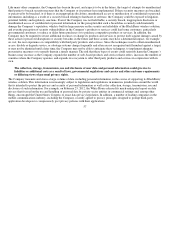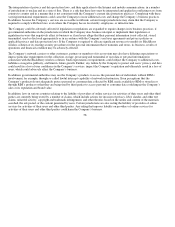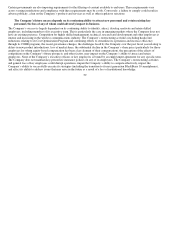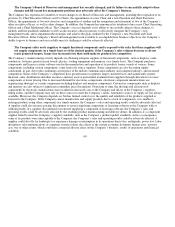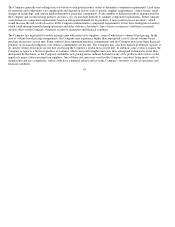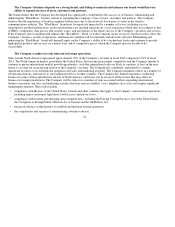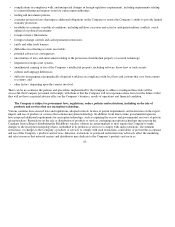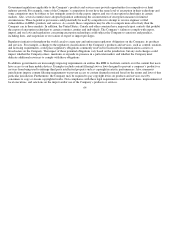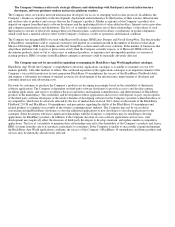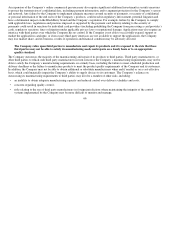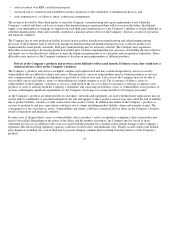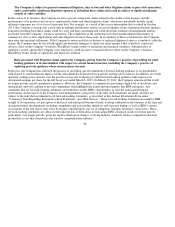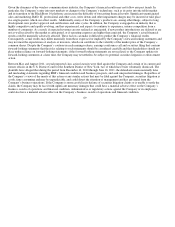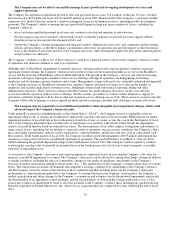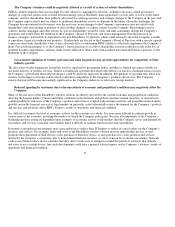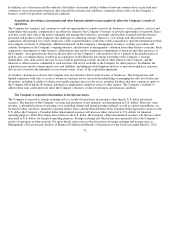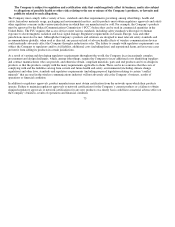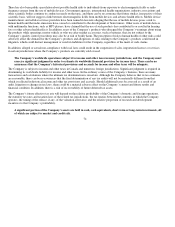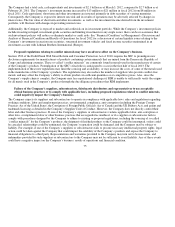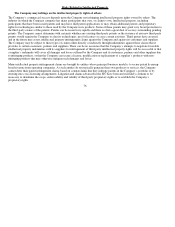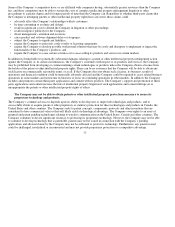Blackberry 2012 Annual Report Download - page 75
Download and view the complete annual report
Please find page 75 of the 2012 Blackberry annual report below. You can navigate through the pages in the report by either clicking on the pages listed below, or by using the keyword search tool below to find specific information within the annual report.
The resources devoted by these third parties to meet the Company’s manufacturing and repair requirements is not within the
Company’s control and there can be no assurance that manufacturing or repair problems will not occur in the future. Insufficient
supply or an interruption or stoppage of supply from such third party manufacturers or the Company’s inability to obtain additional or
substitute manufacturers when and if needed, could have a material adverse effect on the Company’s business, results of operations
and financial condition.
The Company has its own production facility focused on new product introduction manufacturing and related manufacturing
processes. If the Company fails to effectively manage its manufacturing and manufacturing processes so that its products are
manufactured to meet quality standards, third party manufacturing may be adversely affected. The Company may experience
difficulties in increasing or decreasing production at third party facilities, implementing new processes and finding the most effective
and timely way to develop the best solutions to meet the technical requirements of its customers and of regulatory authorities. These
difficulties may increase as the Company continues to develop an increasing number of different products.
Defects in the Company’s products and services can be difficult to detect and remedy. If defects occur, they could have a
material adverse effect on the Company’s business.
The Company’s products and services are highly complex and sophisticated and may contain design defects, errors or security
vulnerabilities that are difficult to detect and correct. Design defects, errors or vulnerabilities may be found in products or services
after commencement of commercial shipments or provision of such services and, if discovered, the Company may not be able to
successfully correct such defects, errors or vulnerabilities in a timely manner or at all. The occurrence of defects, errors or
vulnerabilities in the Company’s products or services could result in the loss of or delay in customer or end user acceptance of its
products or services and may harm the Company’s reputation, and correcting such defects, errors or vulnerabilities in its products or
services could require significant expenditures by the Company, involving cost or time and effort of Company personnel.
As the Company’s products are integrated into its customers’ networks and equipment, are used with third party applications and are
used to deliver confidential or personal information, the sale and support of these products and services may entail the risk of liability
due to product liability, warranty or other claims tied to the security of data. In addition, the failure of the Company’s products or
services to perform to end user expectations could give rise to claims including product liability claims and warranty claims. The
consequences of any such defects, errors, vulnerabilities and claims could have a material adverse effect on the Company’s business,
results of operations and financial condition.
In some cases, if design defects, errors or vulnerabilities affect a product’s safety or regulatory compliance, then such product may
need to be recalled. Depending on the nature of the defect and the number of products, the Company may be forced to incur
substantial recall costs, in addition to the costs associated with the potential loss of future orders and the damage to the Company’s
reputation. Recalls involving regulatory agencies could also result in fines and additional costs. Finally, recalls could result in third-
party litigation, including class action litigation by persons alleging common harm resulting from the purchase of the Company’s
products.
67
•
reduced control over RIM’s intellectual
p
ro
p
ert
y
;
•
increased risk of counterfeit and fraudulent activities
g
ivin
g
rise to the availabilit
y
of unauthorized devices; and
•
earl
y
termination of, or failure to renew, contractual arran
g
ements.


